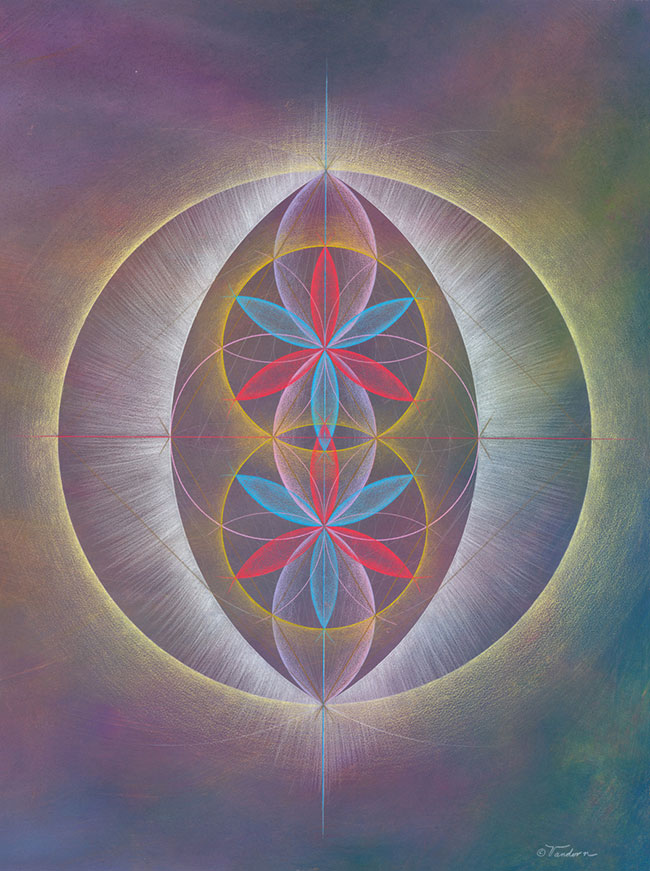Vandorn Hinnant, born in Greensboro, North Carolina, in 1953, is a distinguished artist whose career spans several decades, encompassing a wide range of mediums and thematic explorations. His work is a testament to his profound understanding of art, science, and spirituality, merging these fields into compelling visual narratives.
Hinnant’s artistic journey began in Greensboro, where he was born and raised. He pursued his passion for art by obtaining a Bachelor of Arts degree in Art Design from North Carolina A & T State University. Further honing his skills, he studied sculpture at the University of North Carolina at Greensboro. This formal education laid the foundation for his multifaceted approach to art, blending technical skill with conceptual depth.

In 1993-1994, he received the prestigious North Carolina Arts Council Artist Fellowship Award. Hinnant has also participated in various artist residencies, including The Hambidge Center for the Arts and Sciences, Project Row Houses, Penland School of Crafts, and the Brandywine Workshop. These residencies allowed him to immerse himself in different artistic communities, broadening his perspective and refining his craft.
Beyond his practice as an artist, Hinnant has contributed to the art world as an educator and curator. From 2007 to 2010, he taught a unique mandala printmaking class at Duke University through the Osher Lifelong Learning Institute (OLLI). This “no tech” class emphasized the meditative and therapeutic aspects of art, aligning with Hinnant’s belief in the transformative power of creativity.
Hinnant has also served as a guest curator, juror, and lecturer at different colleges and universities, sharing his expertise and inspiring the next generation of artists. His work as a museum preparator for his alma mater and the Diggs Gallery at Winston Salem State University further underscores his commitment to nurturing artistic talent and fostering a vibrant cultural landscape.
Hinnant’s work has been featured in various exhibitions over his forty-five-year career. One of his early exhibitions was the 1980 group exhibition ‘Afro-American Artists – NC USA’ at the North Carolina Museum of Art. This show highlighted the contributions of African American artists in North Carolina.
In 1993, Hinnant had a solo exhibition titled “Expanded Visions” at the Hammonds House Galleries in Atlanta, GA. Another significant exhibition was his 1999 installation/residency “Pattern: Reflection of Universal Order” at Project Row Houses in Houston, TX. This project highlighted his interest in patterns and their universal significance, a theme that recurs throughout his work.
Hinnant’s inclusion in the 2009 “Rhythm of Structure Math/Art” collaborative exhibition further emphasized his unique approach to art, which integrates mathematical principles and artistic expression. This exhibition traveled from The Bowery Poetry Club in NYC to Antioch College in Ohio and The Ringling School of Art & Science in Florida.
More recently, Hinnant’s work was featured in the exhibition “Vandorn Hinnant: Lover of Form and The Beauty of Number,” which toured three Historically Black Colleges and Universities (HBCUs) in the South. In 2018, his solo exhibition “HIDDEN MATHEMATICS: Images by Vandorn Hinnant – A Surprising Connection Between Math and Art” was showcased at the New York Hall of Science, underscoring his ongoing exploration of the interplay between art and mathematics.
Hinnant’s work is deeply rooted in Modernist abstraction, with drawing at the core of his practice. Over the past two decades, his work has increasingly incorporated the principles of Sacred Geometry, creating harmoniously balanced compositions that resonate with both scientific precision and spiritual depth. His 2D work is described as “a refined synthesis of abstract expressionist painting and Sacred Geometry drawings,” blending fluidity and structure in a seamless dialogue.
Hinnant’s sculptural work complements his drawings, extending his exploration of form and space into three dimensions. His sculptures, whether suspended from ceilings or placed on pedestals, maintain the same conceptual rigor and aesthetic elegance as his two-dimensional pieces. Notable examples include “Together We Rise,” a commemorative monument for the 1913 merger of Winston and Salem, NC, and “A Monument to Leadership” at Fayetteville State University.
One of Hinnant’s works is “Before WE Knew: From The MOTHER of Everything.” This piece explores the concept of creation, symbolized by an all-encompassing circle representing the ‘womb of creation.’ The work delves into the idea of divine feminine origins, juxtaposing red and blue as polar opposites, akin to the yin/yang dynamics. The intricate geometry within the piece, including vesica pisces and subtle straight lines, invites viewers to contemplate deeper connections between art, life, and the universe.
Hinnant’s commitment to using art as a tool for social change is evident in his numerous public art projects and charitable exhibitions. His works are held in private and corporate collections across North America, Africa, and Europe, reflecting their broad appeal and universal relevance.
Hinnant continues to push the boundaries of his art, exploring new media and conceptual frameworks. His book, The Rest of Euclid: An Ancient Architecture of Arithmetic and the Modern Theory of Number, co-authored with Robert L. Powell Sr. and Jr., and published in December 2022, is a treatise on the implications of Euclid’s propositions, further bridging the gap between art and science.
In summary, Vandorn Hinnant’s career is a testament to his unwavering dedication to exploring the intersections of art, science, and spirituality. His work challenges viewers to see beyond the surface, engaging with the profound connections that underpin our existence. Through his innovative approach and thoughtful compositions, Hinnant continues to inspire and captivate audiences worldwide.

